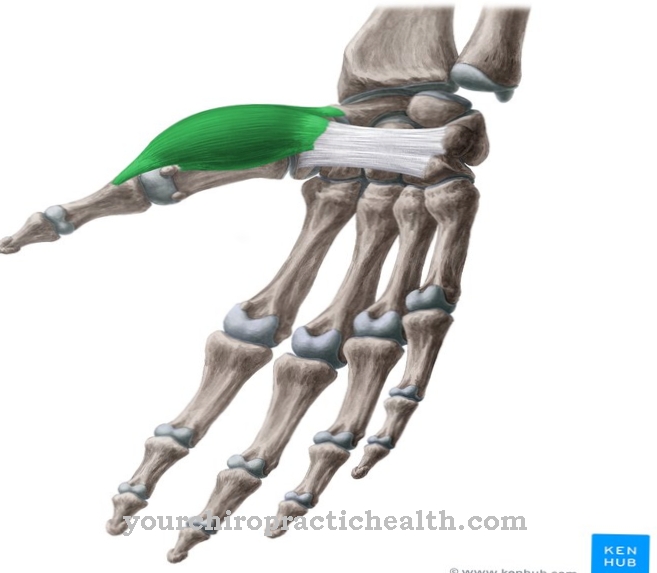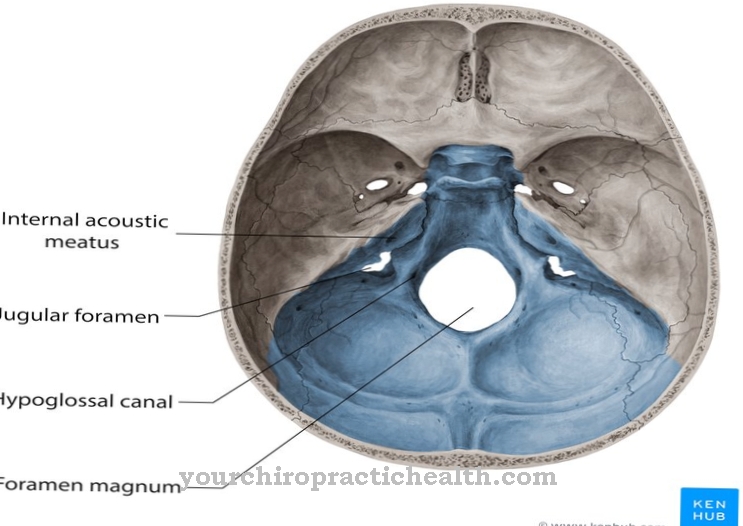Of the Paleocortex is part of the cerebrum. Together with the archicortex, it forms the allocortex. He is responsible for the olfactory processing in the brain.
What is the paleocortex?
The paleocortex or Paleocortex belongs to the cerebral cortex, the cerebral cortex. The word "Paleo" means "primeval". Historically, the cerebrum consists of the striatum, the paleocortex, the archicortex and the neocortex.
From a phylogenetic point of view, the palaeocortex is, according to its name, the oldest part of the cerebral cortex. Together with the archicortex, it forms the allocortex. With its structures, it forms the olfactory brain. In addition, it takes up a small part of the frontobasal cerebrum. The paleocortex is divided into three layers. Its tasks include the reception and transmission of all olfactory impulses from the olfactory nerves. The olfactory impressions are processed and discriminated through the olfactory brain. The olfactory bulb belongs to the paleocortex. This is visually reminiscent of a butterfly sensor.
From an evolutionary point of view, the sense of smell is an important source of information. Other sensory impressions such as taste are strongly connected to it. In addition, this system warns very urgently of dangerous situations. Anatomically, the peculiarity is shown in the form that, unlike other sensory impressions, the information of the smell is passed from the nose directly to the cerebral cortex. The otherwise existing switching in the thalamus is completely eliminated here.
Anatomy & structure
The cerebral cortex or the cerebral cortex is part of the endbrain.This is called the telencephalon and histologically consists of the isocortex and the allocortex.
Together with the archicortex, the paleocortex forms the allocortex. Both make up over 50% of the bark volume. In the course of evolution, it has continuously lost its scope and importance. The allocortex consists of three layers. In detail, these are called the lamina molecularis or stratum molecularis. It omits the apical dendrites of the pyramidal cells. The second layer forms the lamina pyramidalis or also known as the stratum pyramidale. It contains the cell bodies of the pyramidal cells. The last layer is the lamina multiformis or stratum oriens. The basal dendrites of the pyramidal cells are located in it.
The paleocortex is also known as the olfactory cortex. It includes the olfactory tract and the olfactory cortex. In detail, the paleocortex consists of the olfactory bulb and the olfactory tract. It also includes the olfactory tubercle, the septum with the stria diagonalis and the prepiriform cortex. Likewise, cortical parts of the amygdaloid body are assigned to the paleocortex. Part of the olfactory cortex is part of the amygdala.
Function & tasks
From the paleocortex, olfactory information is passed on to various vegetative centers and the thalamus. The thalamus then forwards the signals to the frontobasal neocortex areas. These form the so-called secondary olfactory cortex. There the perceived information is analyzed, interpreted and recognized.
The olfactory system regulates an important function in the detection of dangerous situations. This includes situations like fire, but also poisonous food. In this way, the paleocortex controls life-sustaining appetite and averting movements in dangerous situations. The paleocortex is responsible for behavior such as nausea in the case of nauseating smells. Likewise, pleasant smells are interpreted by him and trigger vegetative reactions. Positive stimuli such as the smell of tasty food cause processes such as salivation through its activity. During reproduction, the paleocortex assumes a kind of selection function of partner choice.
The partner's smell is crucial in mating behavior and elements such as family planning. The organism uses the body odor to automatically and thus unconsciously check whether the potential partner is sufficiently suitable for the preservation of the species with regard to its immunogenetic equipment. For evolutionary reasons, couples are found with the aim that the possible offspring should receive the optimal genetic makeup. The defense against diseases and thus the preservation of the species can only be guaranteed with a stable immune system and a strong body.
The amygdaloid corpus is located in the anterior third of the temporal lobe and has fiber connections to important centers of the limbic system. Here they play an essential role in the emotional modulation of vegetative parameters. These are important in managing behavior that is triggered by fear and anger.
You can find your medication here
➔ Medicines against memory disorders and forgetfulnessDiseases
Impairments and lesions in the paleocortex lead to a loss of important social and emotional functions.
Even a cold suggests what effects lesions in the paleocortex can have. The odor is absorbed by the receptor cells in the nasal mucosa. If these are not fully functional due to swelling, this affects the processing of odors. They can lead to the fact that odor can no longer be perceived and interpreted. It also affects the sense of taste. The sense of smell and taste are directly related to each other. Food and drinks lose their taste as soon as the sense of smell is impaired.
The functioning of the palaeocortex can be influenced by the use of medication. For example, when you take contraceptives such as birth control pills, your sense of smell changes. This has an impact on partner choice and thus on reproduction.
The paleocortex plays an important role in the learning of emotional memory contents. Memories are stored in the memory more detailed and longer when they are linked to smells. This means that positive smells are recognized more quickly and a greater distance is kept from dangerous smells. In the case of illness, this process can no longer take place sufficiently.












.jpg)



.jpg)










.jpg)
